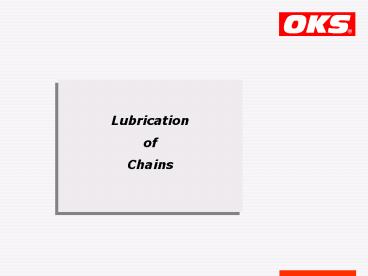PowerPoint-Pr - PowerPoint PPT Presentation
Title:
PowerPoint-Pr
Description:
of. Chains. The Chain. is one of the eldest traction and drive components, consisting of individual links. gripping movable into each other. ... – PowerPoint PPT presentation
Number of Views:52
Avg rating:3.0/5.0
Title: PowerPoint-Pr
1
Lubrication of Chains
2
The Chain
is one of the eldest traction and drive
components, consisting of individual
links gripping movable into each other.
3
Open link chains functioning without lubrication
stud-link or anchor chain
normal open-link chain
caterpillar-type drive chain (similar to track
chains)
4
Base of the Chain Lubrication
All other Chains need an optimal Lubrication!
5
Link ChainsMakes and Shapes
Load chains
Drive chains
6
Load Chains
Liner chains
Fly-frame chains (without chain sprockets)
7
Drive Chains
Roller chains
Bush chains
Rotary chains
8
Construction of roller chains
Bushing
Pin
Roller
Side bar or plate
9
Types of Drive Chains
Single-row roller chain
Double-row roller chain
Triple-row roller chain
10
Types of Conveyor Chains
11
Failures and their Reasons
12
Dependence of Wear, ChainElongation and kind of
Lubrication
13
Ways of Lubrication
Depending on the speed of the chain v m/s
Pump lubrication
Slash lubrication
Drip lubrication
Hand lubrication
14
Hand Lubrication
Lubrication by oil can or brush is a very unsure
method. It is not useful for continuous operation
and therefore only suitable for driving units of
minor importance and slow chain speeds.
15
Drip-feed Lubrication
Lubrication by wick, needle or drip oiler is
suitable for driving units with low stress. In
order that the lubricant will attain the
linkages, the dripping pipes outlets have to be
placed above the pin row.
16
Splash Lubrication in Oil Bath
A chain protection case has a soundproofing
effect. Its dimension should be such big, that
the elongated chain does not beat against the
walls. The chain pins should immerse into the
bath not more than to the rollers or bushings. At
the oil bath there is no loss of the lubricant.
17
Forced-feed circulatory Lubrication
Used for fast running chains and subject to high
loads. Oil feeding may be carried out by
connecting it to an already installed pressure
oil pipe or a pump. The oil spurts from the pipe
on the whole width of the chain on the inner side
of the pulling strand and in direction of the
course.
18
Requirements on the Lubricant
19
Service Temperature rangeof OKS Products
with MoS2
with MoS2 Mox - Active
with white solid lubricants Mox -Active
with Mox - Active
with graphite
with graphite
20
Thank You for Your Attention






























